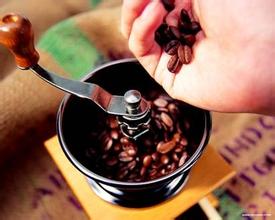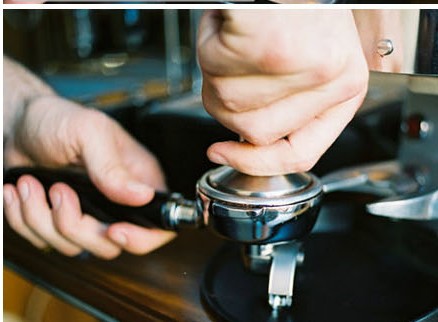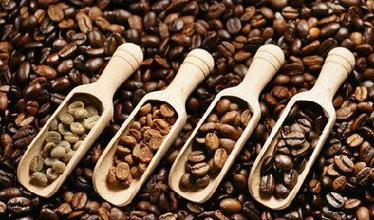Espresso production: the grinding degree correctly adjusts the grinding scale of the coffee grinder to grasp the thickness and fineness.

First of all, the strength of powder pressing is not a condition for adjusting the degree of grinding. The strength of powder pressing should be relatively stable. After adjusting the degree of grinding, the strength of the pressing powder can be adjusted appropriately, either large (when the degree of grinding is slightly thickened) or smaller (when the degree of grinding is slightly adjusted). In order to make the coffee flavor performance more stable. In other words, the degree of grinding is a factor that affects the strength of the powder to a certain extent, not with the change of the strength of the powder, but in the case of the adjustment of the degree of grinding.
The freshness of coffee beans is one of the factors affecting the grinding degree. Freshly roasted coffee beans because of the high activity of flavor components, do not need too fine grinding degree to emit enough flavor, so the grinding degree can be adjusted properly. At this time, if you still take a fine degree of grinding, coffee bean flavor components can be more divergent, but at this time it is easier to extract miscellaneous flavor and astringent taste, under the balance, it is more appropriate to use a thicker degree of grinding. On the other hand, with the decline of the freshness of coffee beans, it is necessary to use fine grinding to extract the flavor components that have lost their activity.
The change of humidity is also one of the factors affecting the degree of grinding. When the humidity is relatively high, the wet speed of the ground coffee powder is very fast, and there is already a slight humidity when filling the powder and cloth powder. If a fine grinding degree is used, the coffee flavor components have already reacted with the air with high humidity and become messy and impure, while the coffee powder is easier to be compacted and the extraction process is longer, which makes it easier to extract the bad taste and make the overall coffee taste muddy. Therefore, in the case of relatively high humidity, it is not suitable for a finer degree of grinding, it will be better to use a slightly thicker degree of grinding. On the other hand, in the case of relatively low humidity, coffee powder is ground out after contact with the air, the speed of oxidation reaction will also be accelerated, if the coarse grinding degree is used, then the coffee powder oxidation and flavor composition changes together make the extracted coffee taste will be less, lack of depth and mellow feeling, so the degree of grinding should be adjusted appropriately. Of course, after adjusting the degree of grinding, the corresponding adjustment of powder strength is also necessary.
Humidity factors play a role not only in sunny and rainy days, but also at different times of the day. Generally speaking, the humidity in the morning and evening is higher than that at noon, so according to the influence of humidity factors, the grinding degree should be thickened in the morning and evening, and finer at noon.
There are many other factors that affect the degree of grinding, including the roasting degree of coffee beans (although coffee beans used by Espresso should use a deeper roasting degree, but sometimes different roasting degrees may be used to roast formula beans for richer taste), blended recipes, and so on. All of the above are the most common and can be mastered by baristas. The previous sections are all about the adjustment of the basic factors in the production process in order to meet that taste standard on the premise of understanding the good taste of Espresso (see the taste of Espresso). There are many places in the world of Espresso that we don't fully understand, and we would like to explore this wonderful world of coffee with you.
Source: happy Coffee Xiao Xu's blog
Important Notice :
前街咖啡 FrontStreet Coffee has moved to new addredd:
FrontStreet Coffee Address: 315,Donghua East Road,GuangZhou
Tel:020 38364473
- Prev

Espresso production: the skill of Coffee Powder pressing effect of Coffee Powder strength on Coffee quality
Powder pressing is a very important step in the manufacturing process of Espresso. We have already talked about the importance and requirements of pressing powder. So is the use of pressing powder as strong as possible? What does the power of powder pressing have to do with it? Theoretically speaking, with the difference of the thickness of the coffee powder, that is, the grinding degree of the coffee powder, the force of the pressing powder should be adjusted accordingly. The coarser the coffee powder is ground
- Next

Coffee bean flavor characteristics of single mixed coffee and blended coffee
The mixed coffee here is a kind of single coffee (pure drinking coffee). As the name implies, mixed coffee is a combination of several different coffee beans. The process of combining several different coffee beans is the blending process of comprehensive coffee. The reason why there is no need to mix such words here is because the blending process of mixed coffee is not a simple mix, which depends on different coffee.
Related
- What is the meaning of lactic acid fermentation with coffee bean treatment?
- How to judge the state of foam by sound?
- How does the latte pull out the unicorn pattern? Come to get for a little trick to improve the flower pull!
- Will flower pulling affect the taste of the latte?
- Do you know the history of coffee?
- The difference between honey treatment and sun washing what is raisin honey treatment?
- What kind of milk can a novice use to make coffee foam to keep the foam longer? The correct method and skills of milking tutorial sharing
- Why do washed coffee beans taste sour? Flavor characteristics of washed Coffee
- Introduction to the skill of how to practice the size and height of water injection around the circle of hand-brewed coffee
- How do beginners practice coffee flower drawing from scratch?

